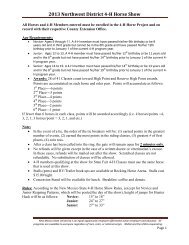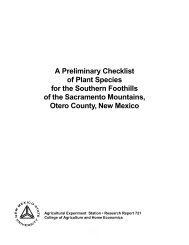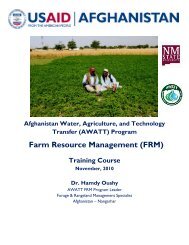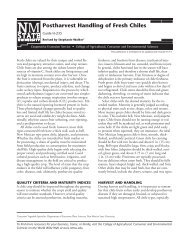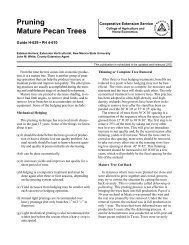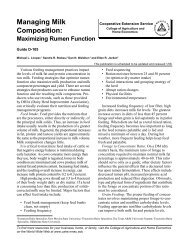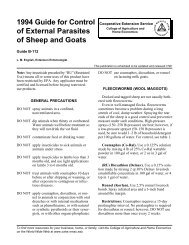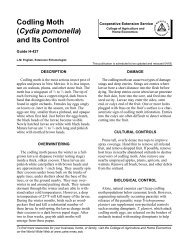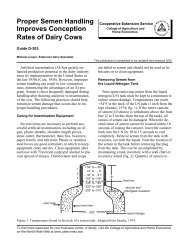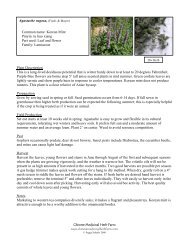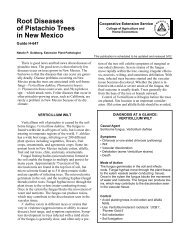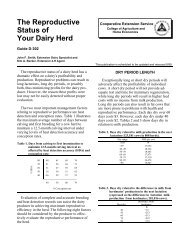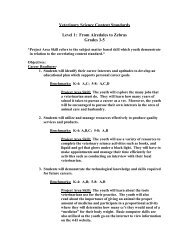PDF Version - NMSU's College of Agriculture and Home Economics ...
PDF Version - NMSU's College of Agriculture and Home Economics ...
PDF Version - NMSU's College of Agriculture and Home Economics ...
You also want an ePaper? Increase the reach of your titles
YUMPU automatically turns print PDFs into web optimized ePapers that Google loves.
the nitrate-N content <strong>of</strong> the soil via leaching. Samplestaken before a leaching event will overestimatethe soil inorganic-N <strong>and</strong> subsequently underestimatethe amount <strong>of</strong> nitrate-N that would be needed for apotential crop.Phosphorus (P) (Method S – 4.10 in Gavlak etal. [2005])Western soils are typically alkaline <strong>and</strong> should haveplant-available phosphorus determined using a sodiumbicarbonate solution (Olsen’s procedure). Thisextract has been shown to correlate very well withplant-available phosphorus in high-pH (alkaline)soils. New Mexico soils that are low in organic matterusually are also low in plant-available phosphorus.Soil chemistry in New Mexico favors the creation<strong>of</strong> apatite (a calcium phosphate mineral) that is notavailable for plants to use. As a result, plant-availablephosphorus is usually quite low in alkaline soils <strong>and</strong>should be supplemented for growing plants. Phosphorusfertilizers can be applied at 1/5th the nitrogenrate when making routine applications.Potassium (K) (Method S – 5.10 in Gavlak et al.[2005])The accepted method for determining plant-availablepotassium is extracting the soil with an ammonium acetatesolution. Before NMSU’s SWAT laboratory closedthey used water-extractable potassium, which is a fraction<strong>of</strong> the extractable potassium for most soils. However,the value <strong>of</strong> one method over another is related tounderst<strong>and</strong>ing <strong>of</strong> plant response to reported values. Lowpotassium, as well as other nutrient levels that are reportedlow, will generally mean a good chance for plantresponse to added fertilizer.Micronutrients (Method S – 6.10 in Gavlak etal. [2005])Iron (Fe): Iron is extracted with DTPA (a chelate) bymost soil testing labs in the West. Iron deficiencies canoccur with sensitive plants grown in alkaline or calcareoussoil. If the soil pH is above 7.5, less iron is availableto the plant because the chemistry <strong>of</strong> the soil favors thecreation <strong>of</strong> a mineral form <strong>of</strong> iron that is not availablefor plant use. Even though a soil may test high in availableiron, iron-sensitive crops may still exhibit deficiencysymptoms. Chelates <strong>of</strong>ten are used to keep iron fertilizersin a more available form, but care should be taken topick EDDHA or DTPA as the chelate <strong>of</strong> choice in NewMexico instead <strong>of</strong> EDTA. EDDHA is most stable acrossall soil pH ranges, while DTPA should not be used insoil with a pH above 7.6. These two classes <strong>of</strong> chelateswill generally improve iron nutrition in plants.Zinc (Zn): Zinc, like iron, is extracted with DTPA bymost labs in the West. Zinc can be an economic problemfor many crops like corn, sorghum, <strong>and</strong> pecans. Zincis most unavailable in soils with pH greater than 7.5. Extremelyhigh levels <strong>of</strong> phosphorus can cause zinc deficienciesby competing for adsorption sites on the soil. Soil testresults are classified as low, medium, or high.Copper (Cu): Copper deficiencies have not been verifiedin New Mexico soils. Factors that contribute to copperdeficiency are high organic matter, s<strong>and</strong>y textural class,<strong>and</strong> very high pH. Copper toxicities, on the other h<strong>and</strong>,have been an issue in some New Mexico fields that havebeen treated with copper-containing amendments.Manganese (Mn): Manganese deficiencies have begunto show up in pecans <strong>and</strong> some other crops in NewMexico. Deficiency symptoms can occur under the sameconditions that promote iron <strong>and</strong> zinc deficiencies.Boron (B) (Method S – 7.10 in Gavlak et al. [2005]):Boron is another micronutrient that is needed by plantsbut is usually sufficient in soils in low rainfall areas.Plant tissue testing can indicate whether or not there issufficient boron available to the plant. Some plants suchas pistachios can exhibit boron deficiency. Soil levels areassessed using a hot water extract <strong>of</strong> the soil. Treatingplants or soil with boron should be approached withcaution because <strong>of</strong> the potential for boron toxicity ifover-applied.Sulfate (SO 4-S) (Method S – 11.10 in Gavlak et al.[2005]): S<strong>and</strong>y soils are prone to sulfur deficiencies.However, addition <strong>of</strong> organic matter, sulfate-containingfertilizers, <strong>and</strong> irrigation water <strong>of</strong>ten supplies enoughfor crop needs. For more information on sulfur in NewMexico, see Circular 650, Sulfur <strong>and</strong> New Mexico <strong>Agriculture</strong>(http://aces.nmsu.edu/pubs/_circulars/CR-650.pdf).Soil Texture (Method S – 14.10 in Gavlak et al.[2005], or Thien [1979])Soils are composed <strong>of</strong> mineral particles with an infinitenumber <strong>of</strong> sizes <strong>and</strong> shapes. Individual mineral particlesare divided into three major categories based on theirsize: s<strong>and</strong>, silt, or clay. Many <strong>of</strong> soil’s important physical<strong>and</strong> chemical properties are associated with the surface<strong>of</strong> these particles. Soil texture is most <strong>of</strong>ten estimated bythe “feel” method, but sieves or hydrometer readings canbe requested, usually at a much higher price. Soil texturegives a preliminary indication about the soil’s waterholdingcapacity.Guide A-146 • Page 4



